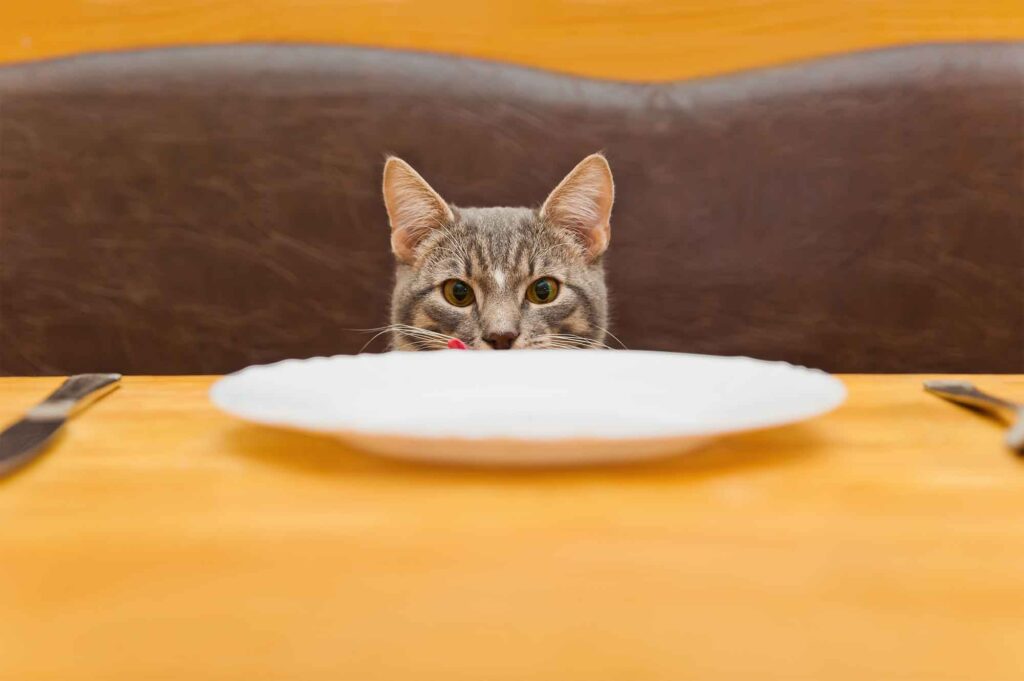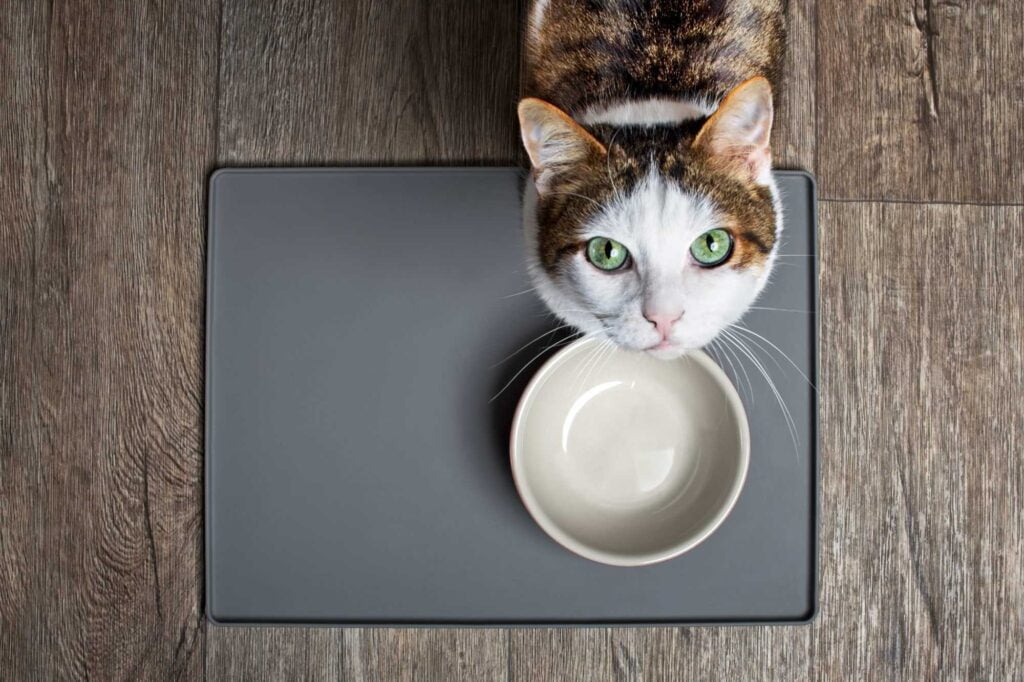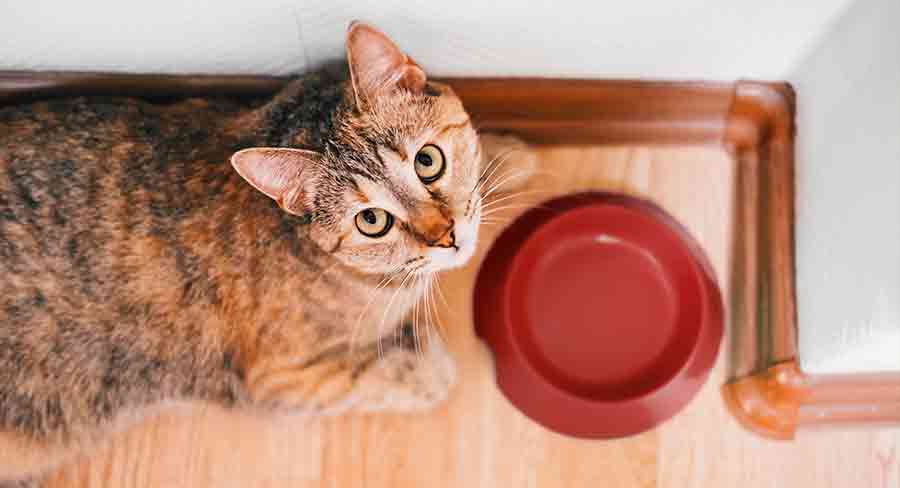The Ultimate Guide to Feeding Your Cat When You’re Out of Cat Food

Having trouble feeding your cat when you are out of cat food? Here’s what to do!
As a cat owner, one of the worst things that can happen is running out of cat food. Whether it’s because you forgot to restock or you’re in an emergency situation, it can be stressful trying to figure out what to feed your pet cat. Fortunately, there are plenty of options available to keep your cat happy and healthy even when you’re out of cat food.
In this ultimate guide, we’ll explore various alternatives to cat food, discuss the pros and cons of each option, and provide helpful tips for feeding your cat during a food shortage.
What to Feed Your Cat When You Are Out of Cat Food

Cats can eat a variety of foods if you have run out of cat food. However, it’s important to remember that meeting cats’ unique nutritional requirements is crucial for maintaining their health. As such, it’s important to be cautious when selecting alternative foods to feed your cat.
Here’s a list of different types of foods that you can feed your cat:
1. Cooked Meat
Cats are obligate carnivores, which means that they require a diet rich in protein. While it’s important to provide your cat with a balanced and nutritionally complete diet, cooked meat can be a good source of protein for your feline friend when you run out of cat food.
However, it’s important to keep in mind that not all types of meat are suitable for cats and some can be harmful or toxic. When feeding your cat cooked meat, it’s important to avoid any seasoning, bones, or fat as these can cause digestive upset or other health issues.
Additionally, the meat should be cooked thoroughly to avoid any risk of bacterial contamination. It’s also best to introduce cooked meat gradually into your cat’s diet to avoid any digestive issues. Here are some types of cooked meat that cats can safely eat:
- Chicken: Plain boiled or grilled chicken is a great source of lean protein for cats.
- Turkey: Cooked turkey is another good option for cats and can provide a healthy dose of protein.
- Beef: Cooked beef can be fed to cats in small amounts as a source of protein, but it should be lean and without any seasoning or fat.
- Lamb: Cooked lamb is another great source of protein for cats, but it should also be lean and without any seasoning or fat.
- Salmon: Cooked salmon is a good source of protein and omega-3 fatty acids for cats.
- Fish: Cooked fish is also an option for cats, but it’s important to avoid any bones and to make sure the fish is fully cooked to avoid any risk of bacterial contamination.
2. Canned Fish
While many cat owners prefer to feed their cats fresh or raw meat, canned fish can be a convenient and affordable alternative. Canned fish can provide cats with a good source of protein, omega-3 fatty acids, and other important nutrients.
However, not all types of canned fish are suitable for cats, as some may contain high levels of mercury or other toxins that can be harmful to cats in large amounts. Therefore, it’s important to choose the right type of canned fish for your cat and to feed it in moderation. Here are five types of canned fish that are safe and healthy for cats to eat.
- Canned Tuna: Tuna is a popular option for cat owners, but it should be given in moderation due to high levels of mercury. Choose tuna packed in water instead of oil and avoid giving your cat flavored varieties.
- Canned Salmon: Salmon is a good source of protein and omega-3 fatty acids for cats. Look for canned salmon that is boneless and skinless.
- Canned Sardines: Sardines are a great source of protein, omega-3 fatty acids, and other nutrients for cats. Choose sardines packed in water or olive oil instead of soybean or other vegetable oils.
- Canned Mackerel: Mackerel is another type of fish that can be safely fed to cats in moderation. Look for canned mackerel that is free from additives and preservatives.
- Canned Anchovies: Anchovies are a good source of protein and omega-3 fatty acids for cats, but they should be given in moderation due to their high sodium content. Choose anchovies packed in water or olive oil instead of salt.
3. Cooked Vegetables
While cats are obligate carnivores, meaning they require meat to meet their dietary needs, some cooked vegetables can still provide additional nutritional benefits. Moderation is key when it comes to feeding cats vegetables, as they have different nutritional requirements than humans.
Some vegetables that are safe for cats to eat when cooked can provide a good source of vitamins, minerals, and fiber. It’s important to note that not all vegetables are safe for cats to consume, and some can even be toxic. Therefore, it’s crucial to research which vegetables are safe and appropriate for cats before incorporating them into their diet.
Here are six cooked vegetables that are considered safe for cats:
- Carrots: Cooked carrots can be a good source of fiber, vitamin A, and beta-carotene for cats.
- Green beans: Cooked green beans are a good source of fiber and can help with digestion in cats.
- Squash: Cooked squash can provide a good source of vitamins A and C, as well as fiber for cats.
- Broccoli: Cooked broccoli can be fed to cats in small amounts as a source of fiber and vitamin C.
- Sweet potato: Cooked sweet potato is a good source of fiber and vitamins for cats, but it should be fed in moderation due to its high carbohydrate content.
- Peas: Cooked peas can be a good source of protein, fiber, and vitamins for cats, but they should be fed in moderation as they are high in carbohydrates.
4. Fruits
While it’s always best to feed your cat a balanced diet that meets their nutritional needs, in a pinch, some fruits can offer a healthy addition to your cat’s diet. It’s important to remember that cats require a meat-based diet, but adding small amounts of certain fruits can provide a variety of vitamins and minerals that can support their overall health.
However, it’s crucial to ensure that the fruits you offer are safe for cats to consume and that you don’t rely on them as a long-term food source. With that said, here are seven safe fruits that you can consider feeding your cat in moderation when you’re out of cat food:
- Blueberries: These contain antioxidants and can support a cat’s immune system.
- Bananas: Rich in potassium, fiber, and vitamin C, bananas can help regulate a cat’s digestive system.
- Watermelon: High in water content, this fruit can help keep cats hydrated and also contains vitamins A and C.
- Mango: A good source of vitamin A, mango can support a cat’s skin and coat health.
- Apples: Apples contain fiber and vitamin C, but make sure to remove the seeds and core, as they contain traces of cyanide.
- Pineapple: Rich in vitamin C and bromelain, pineapple can aid in digestion and reduce inflammation.
- Cantaloupe: A great source of vitamins A and C, cantaloupe can also help keep cats hydrated.
5. Grain and Dairy Products
People consider adding grains and dairy products to a cat’s diet a controversial topic, as cats are obligate carnivores and primarily require a meat-based diet. However, you can add small amounts of grains and dairy into their meals, as long as they are given in moderation and do not replace the main source of protein in their diet.
It’s important to note that cats have different nutritional needs than humans and may not be able to digest certain foods, such as lactose found in dairy products.
Here are five grains and dairy products that can be added to a cat’s diet:
- Oatmeal: This grain is a good source of fiber and can help with digestion and bowel movements.
- Brown rice: This grain is also high in fiber and can be a source of carbohydrates for cats.
- Yogurt: If given in moderation, plain, unsweetened yogurt can be a good source of probiotics, which can aid in digestion and promote gut health.
- Cottage cheese: Like yogurt, cottage cheese can be a source of protein and calcium, but it should also be given in moderation due to its lactose content.
- Hard-boiled eggs: Eggs can provide a good source of protein, but it’s important to ensure they are cooked thoroughly and the shells are removed before feeding them to your cat.
Tips for Feeding Your Cat When You’re Out of Cat Food

- Introduce new foods gradually – When introducing new foods to your cat’s diet, it’s important to do so gradually. Sudden changes in diet can cause digestive upset, so it’s best to mix small amounts of the new food with their regular food and gradually increase the proportion over time.
- Monitor your cat’s reaction – Keep an eye on your cat’s reaction to new foods. If they experience any digestive upset or other symptoms like vomiting, diarrhea, or lethargy, discontinue the new food immediately and consult your vet.
- Provide fresh water – Make sure your cat always has access to fresh, clean water, especially when feeding them dry food or treats.
- Store food properly – If you are feeding your cat leftovers or human food, make sure to store it properly in an airtight container in the refrigerator. Discard any food that has been left out for more than two hours.
- Avoid toxic foods – Some human foods can be toxic to cats, such as chocolate, onions, garlic, and grapes. Make sure to avoid feeding your cat these foods.
- Check expiration dates – If feeding your cat canned or packaged foods, check the expiration dates to make sure they are safe to eat.
- Stick to protein-rich foods – Cats are carnivores by nature, which means they require a diet rich in protein. When feeding your cat human food, make sure it contains a good amount of protein.
- Consult your vet – If you are unsure about what to feed your cat or if your cat has any health conditions, consult your vet for advice on a suitable diet.
Conclusion
In conclusion, as a responsible pet owner, it is important to have a plan in place for when you run out of cat food. With the helpful tips and information in this guide, you can ensure that your furry friend receives a nutritious meal, even when you don’t have access to their regular food.
Remember to always prioritize your cat’s health and nutritional needs, and to avoid feeding them anything that may be harmful or toxic. However, it’s important to note that while some human foods may be safe for cats, it’s always best to consult with a veterinarian before introducing any new foods to your cat’s diet. With a little preparation and knowledge, you can ensure that your cat stays healthy and happy, even when you’re out of cat food.



What are the foods that they can eat that people can eat(I’m saying make a list of foods they can eat all in a row)
Here’s a post you’ll find useful: https://thecatspace.com/foods-cats-eat-from-the-fridge/